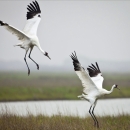Seasons of Wildlife
The salt flats of the Salt Plains National Wildlife Refuge are a major nesting site for the endangered interior least tern, threatened western snowy plover, and American avocet. The flats are also a major migration rest area for hundreds of thousands of shorebirds during spring, summer, and fall. While vegetation on the flats is sparse, the birds feed on the salt brine flies that hatch when water is available.
Many species of wildlife nest directly on the salt flats, making it difficult to see their eggs from a distance. Here, nests of twigs, grasses and other materials are built by birds for hiding their young and caring for them as they develop. The newly hatched young shorebirds are precocious and will not remain in the protective nest long. Within hours of hatching, they are running around the flats foraging for food.
During the winter, whooping cranes utilize the edge of the lake where the salt flats have large areas devoid of any vegetation – hiding spots for predators. The highly endangered cranes can often be found foraging in wheat fields either alone or with sandhill cranes during the fall days. They are easy to identify, standing approximately 4.5 feet tall.
The confluence of several rivers and streams of the Salt Fork River drainage system forms part of the unique environment of Salt Plains National Wildlife Refuge. In addition to the salt flats, the refuge’s grasslands and woodlands produce an extremely productive environment for wildlife where white-tailed deer, eastern fox squirrels, American badger, muskrat, and porcupine thrive.
The wetland, streams and lakes are extremely important to migrating waterfowl and other migratory birds. Peak numbers of ducks, geese, and cranes can approach 400,000 during spring and fall migrations. During the fall through early spring months, geese outnumber all other birds averaging almost 50,000 each year.
Spectacularly large flocks of white pelicans can be seen feeding on the Great Salt Plains lake during spring and fall. Commonly seen waterfowl include mallard, northern pintail, wood duck, redhead, American widgeon, and common merganser. The shallow water, flats, and moist soil units on Salt Plains create ideal conditions for many species of invertebrates, an important food source for long-legged birds like great blue heron and great egrets. The first known breeding record in the State of Oklahoma for the white-faced ibis is found on the refuge’s Ralstin Island. It is not only one of the most important colonial nesting bird areas in the state, but also the largest breeding site in Oklahoma for this species.
Many of the turtles and snakes found on the refuge can be seen sunning themselves along the trails and ponds during the warmer months. Snakes such as the coachwhip and bullsnake, and lizards like the prairie-lined racerunner, are common here. Bullfrogs, leopard frogs, and toads such as the Rocky Mountain toad and the Great Plains toad are well known for their calls that fill the air on spring and summer evenings. Red-eared slider and ornate box turtle are typical species found on the refuge and in the refuge’s lakes, ponds and streams, channel catfish, the predominant gamefish, are abundant along with varieties of bass and other native fish.
Featured Species
Birds are the most common and viewed wildlife on the refuge. The species that are seen change seasonally. The refuge provides wintering grounds for thousands of geese, ducks, and sandhill cranes. The mixture of mixed-grass prairie, riparian riparian
Definition of riparian habitat or riparian areas.
Learn more about riparian forest, and floodplain vegetation supports a variety of songbird species. Shorebirds are commonly seen along the lakeshore and along rivers and creeks.
Mammals, invertebrates, reptiles, amphibians, and fish also call Salt Plains NWR home and can be found here almost year-round. Some of these animals are more secretive, leaving behind evidence of their presence, but when you get a chance to see them it's a joy.



